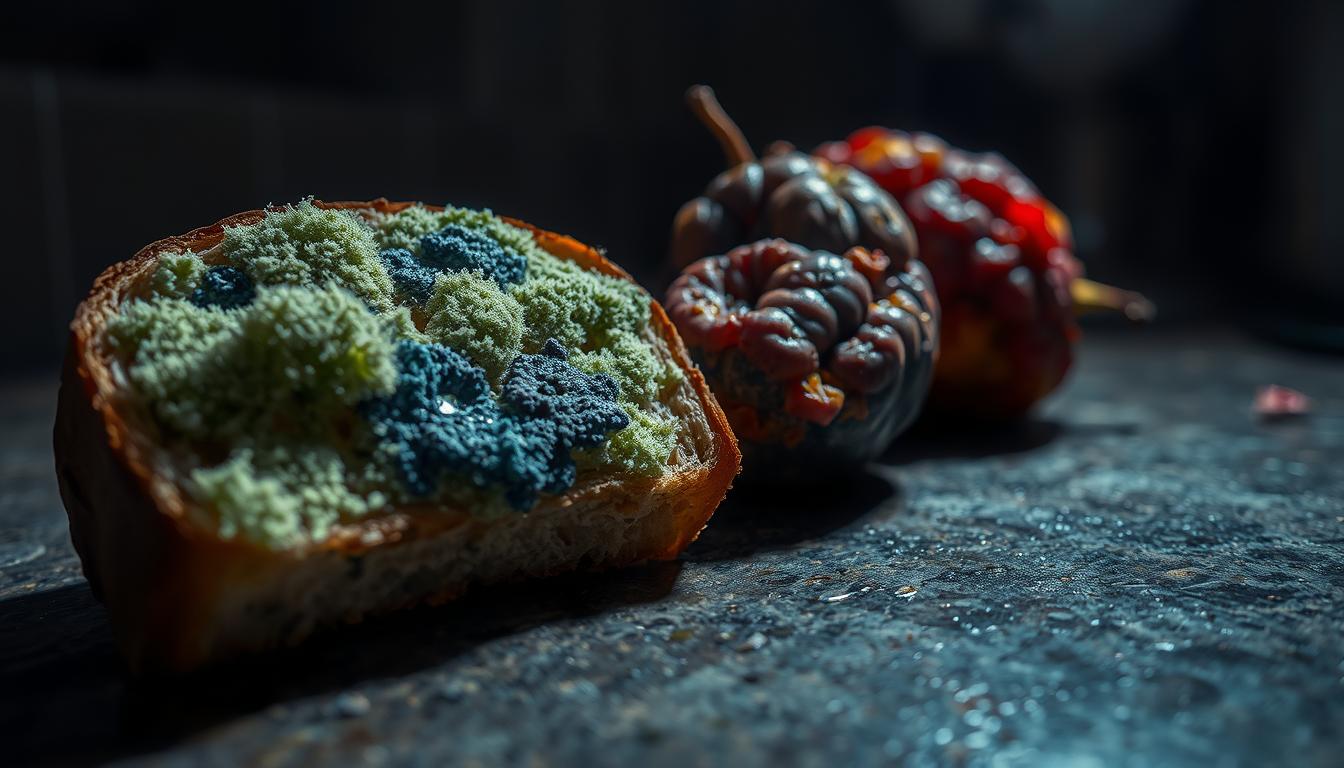Did you know the same fuzzy intruder ruining your bread once revolutionized modern medicine? Penicillin—the world’s first antibiotic—comes directly from a common type of fungus found in households worldwide.
These organisms thrive where moisture and oxygen exist, which explains their widespread presence. Outdoors, they break down leaves and wood, keeping ecosystems balanced. Indoors, however, their natural recycling skills turn against us when they target our groceries.
Thread-like structures called hyphae form colonies visible as discolored patches. Spores—smaller than dust particles—land on surfaces and multiply rapidly when temperatures and humidity align. This process transforms strawberries into mushy casualties and cheese into science experiments.
While essential for decomposing forest debris, these recyclers lack discretion indoors. Your pantry becomes their new forest floor. Recognizing their biology helps you disrupt their life cycle and protect your meals from unwanted texture changes and potential health risks.
Key Takeaways
- Fungi play vital roles in nature but become problematic in food storage areas.
- Visible growth indicates advanced colonization by microscopic spores.
- Temperature and humidity control significantly impact spore activity.
- Structural changes in affected items signal potential safety concerns.
- Ecosystem benefits turn into kitchen challenges under the right conditions.
Understanding Mold and Its Role in Food Spoilage
Mold’s colorful colonies on your leftovers tell a survival story millions of years in the making. These fuzzy invaders belong to the fungus family, recycling nutrients in nature but becoming unwelcome guests in your kitchen. Their secret weapon? Microscopic particles called spores that hitch rides on air currents until landing on vulnerable surfaces.

What Is Mold?
This organism creates visible patches using thread-like roots called hyphae. While surface colors range from green to black, the real action happens beneath. Spores give mold its hue and spread silently through porous items like bread or soft cheeses. You might notice:
- A damp-earth smell signaling hidden growth
- Mushy textures where hyphae invade deep layers
- Bitter flavors from chemical changes in contaminated items
Mold Versus Bacteria in Food
Though both cause spoilage, mold differs from bacteria in key ways. Fungi form complex networks visible to the eye, while single-celled bacteria remain undetectable without magnification. More critically:
- Mold needs oxygen – bacteria thrive with or without air
- Some molds produce toxins, whereas certain bacteria trigger immediate sickness
- Hard foods like carrots might allow safe mold removal, but bacterial contamination usually requires disposal
Both organisms often work together, turning forgotten produce into biohazards. Recognizing their partnership helps you make smarter decisions about food safety.
How Mold Develops on Food: Causes and Conditions
Your kitchen’s invisible invaders need just three things to turn fresh groceries into fuzzy disasters. Temperature, humidity, and airflow work together like a biological alarm clock for spore activation.

Optimal Conditions for Mold Growth
Warmth acts as nature’s incubator. Between 77°F and 86°F, spores awaken like clockwork. Damaged produce becomes prime real estate—bruised apples and torn bread wrappers offer easy access points. Soft cheeses and deli meats provide both moisture content and porous surfaces for colonization.
Impact of Moisture, Temperature, and Oxygen
Water availability determines invasion speed. A single droplet on strawberry skin becomes a fungal highway. While most types suffocate without air, xerophilic varieties defy expectations. These sugar-loving organisms thrive in dried fruits and jams, proving that dryness doesn’t guarantee safety.
Vacuum-sealed packaging starves spores of their oxygen needs, but imperfect seals create micro-environments for growth. Refrigeration slows but doesn’t stop determined fungi—they simply work slower in the cold. The combination of these factors explains why:
- Bread molds fastest in humid summer kitchens
- Pre-sliced melons spoil quicker than whole fruits
- Jarred sauces develop surface fuzz despite preservatives
“Spores don’t need invitations—they crash parties through air vents and cling to shopping bags.”
Understanding this environmental triad helps you disrupt contamination cycles. Adjust storage locations based on seasonal humidity changes, and always inspect food containers for micro-teams that compromise airtight seals.
Identifying Mold: Signs and Foods at Risk
That fuzzy blue spot on your cheddar isn’t just surface decoration—it’s a warning system evolved over millennia. Early detection relies on recognizing subtle clues in appearance, texture, and smell. Knowing which items attract these invaders helps you act before they compromise your entire pantry.

Visual Indicators and Odor Changes
Discoloration often appears first—white fuzz on strawberries or green patches on bread crusts. Softening occurs as hyphae break down cell structures, turning crisp carrots into rubbery hazards. Trust your nose: a musty or sour smell frequently precedes visible growth in porous items like cheese.
High-Risk Foods: Soft Fruits, Vegetables, and Cheeses
Berries and stone fruits top the danger list due to thin skins and high moisture. Tomatoes and bell peppers become fungal targets when their protective wax coatings wear off. Soft cheeses like brie allow deep infiltration, while hard varieties risk surface contamination if stored improperly.
Bread’s porous texture acts like a sponge for airborne spores, especially in humid environments. Always check pre-sliced melons and bagged greens—their high water content creates ideal breeding grounds. Store vulnerable items in breathable containers and consume them quickly to outpace spore activity.
Safe Handling and Disposal of Moldy Foods
Spotting fuzzy growth on your groceries triggers immediate questions about safety. Decisive action prevents invisible threats from spreading through your kitchen. Follow these guidelines to protect your meals and health.

When to Discard Contaminated Items
Soft, moist items require complete disposal. Their porous structures allow mold spores to penetrate deeply, making surface cleaning ineffective. Always throw away:
| Discard Immediately | Potential Risks |
|---|---|
| Berries & stone fruits | Internal spore infiltration |
| Bread & baked goods | Rapid hyphae network growth |
| Deli meats & hot dogs | Toxin production in proteins |
| Yogurt & soft cheeses | Liquid content spore spread |
Never sniff suspicious items closely—inhaling particles may cause respiratory issues. Seal contaminated products in airtight bags before trash disposal.
Strategies for Cutting Around Mold on Hard Foods
Dense items with low moisture sometimes allow salvage operations. For hard cheeses or firm vegetables:
- Use clean knives untouched by affected areas
- Cut 1 inch beyond visible growth in all directions
- Wipe blades between slices to prevent cross-contact
“The one-inch rule accounts for microscopic roots you can’t see. When in doubt, throw it out.”
Peel bananas and citrus thoroughly, as skins trap spores. Always transfer salvaged portions to new containers—original packaging may harbor contaminants.
Preventive Tips for Reducing Mold Growth in Your Kitchen
Your kitchen’s defense against fuzzy invaders begins with smart storage choices. Simple adjustments to food handling and appliance maintenance create hostile environments for unwanted organisms while protecting your groceries.
Proper Storage and Food Safety Practices
Start by rinsing fruits and vegetables under running water. Dry them thoroughly before placing in your refrigerator’s crisper drawer—this compartment maintains ideal humidity levels to delay spoilage. Use airtight containers for cheeses, jellies, and other vulnerable products to block airborne spores.
Set your fridge below 40°F and freezer under 0°F. These temperatures slow microbial activity without freezing most fresh items. Store nut butter jars upside down to create natural seals that prevent oxygen exposure.
Maintaining a Clean Refrigerator and Countertops
Wipe spills immediately using hot, soapy water. Every three months, deep-clean shelves with a solution of 1 tablespoon baking soda per quart of water. This eliminates residual spores and bacteria while neutralizing odors.
Rotate stored products weekly to catch early signs of contamination. Keep countertops dry—moisture from dishrags or fruit bowls invites fungal colonization. Designate separate cutting boards for produce and proteins to minimize cross-contamination risks.
“A clean fridge is your first line of defense. Spores can’t grow where they can’t settle.”
Environmental and Health Considerations
What happens when invisible spores meet sensitive immune systems? For many, contact with contaminated items triggers more than just unpleasant textures—it sparks biological alarms. Reactions vary widely, from temporary discomfort to life-threatening responses requiring immediate care.
Recognizing Allergic Responses
Allergic reactions often begin with respiratory distress or skin irritation. Wheezing, nasal congestion, and rashes may appear within hours of exposure. Those with existing mold sensitivities face heightened risks when consuming affected products, even if visible signs seem absent.
Mycotoxins—poisonous byproducts from certain fungi—can cause severe foodborne illnesses. Symptoms like vomiting and diarrhea typically emerge within 24 hours. In rare cases, contaminated supplements or processed foods trigger unexpected reactions, as seen with Quorn products and tainted bee pollen.
Monitor your body after accidental consumption. Delayed responses sometimes occur days later, complicating diagnosis. Always consult healthcare providers if breathing difficulties or persistent gastrointestinal issues arise following suspected exposure.



